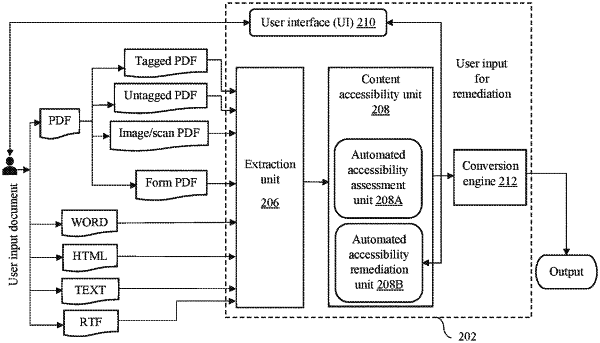| CPC G06F 16/383 (2019.01) [G06F 16/345 (2019.01); G06F 40/103 (2020.01)] | 12 Claims |

|
1. A processor implemented method, comprising:
receiving, via an input/output interface, content from one or more sources as an input, wherein the content from the one or more sources corresponds to:
(i) a ready unstructured document,
(ii) a raw content obtained from a structured database or an unstructured database, and
(iii) a raw content and a design layout obtained from a content management system (CMS) and a combination thereof;
extracting, via one or more hardware processors, one or more features associated with the content, wherein the one or more features correspond to one or more appearance attributes, and wherein the one or more appearance attributes are categorized based on one or more classes associated with the content, wherein the one or more appearance attributes corresponds to at least one of: (i) font properties associated with the one or more content, (ii) position values, (iii) text parameters, (iv) margin values, (v) scale attributes, (vi) border attributes, or (vii) background color, wherein the one or more classes corresponds to one or more categories of element, and the one or more categories of element corresponds to: (i) a textual data that includes a link, a list, abbreviations, headings, paragraphs, a header, and a footer, and (ii) a non-textual data that includes table, forms, images, drawings, and graphic, wherein the images are trained on an information model with Visual Geometry Group (VGG) architecture for 30 epochs with data augmentation to recognize charts and graphs;
assigning a logical reading order to the one or more categories of element using one or more tags that are created in a same hierarchy and dumps the information in a JavaScript Object Notation (JSON) file, wherein an accuracy of assigning the logical reading order is improved by updating the logical reading order of one or more categories of elements;
validating, via the one or more hardware processors, the content by performing a check to identify whether the content is one of accessible content or inaccessible content based on the extracted one or more features, wherein the content is validated using an artificial intelligence (AI) based automated accessibility intervention engine;
dynamically remediating, via the one or more hardware processors, inaccessible content based on one or more accessibility attributes to obtain the accessible content; and
converting, via the one or more hardware processors, the accessible content into accessible formats based the on one or more classes associated with the content and a logical reading order of the content, wherein the logical reading order which is assigned to each element of the content.
|